Introduction
The philosophy and practice of work organisations are deeply rooted in the notion of managerial leadership. However, Leadership is by its very nature dialectical, even though the majority of definitions of the term assume that it entails a process wherein a person influences others in an organisational setting. Therefore, through their interactions, leaders and followers socially construct it. However, a collection of administrative tools is not all that strategic planning and management are.
Also, they make up a mindset, a method that examines how the Chairman and other executive council members of an LGC are confronted by shifting internal and external environments. Therefore, a managerial procedure that necessitates connecting human resource policies and practices with the strategic goals of the company is known as a “strategic approach to HRM.”
Why Is Human Resource Management Strategically Important?
Aligns HR with business strategy:
Makes ensuring that all HR policies and procedures are in line with the organization’s strategic goals.
However, to make sure that the organization’s talent is successfully used to meet its objectives, this alignment is essential.
Enhances organisational performance:
Strategic human resource management is essential to improving overall organisational performance. However, because it places a strong emphasis on employee engagement, talent management, and workforce planning. Therefore, a stimulated and well-managed staff is more creative, productive, and dedicated to attaining the goals of the company.
Strengthens competitive advantage:
However, assists businesses in creating a distinct set of competences through their people resources that are challenging for rivals to copy. Therefore, this could be achieved by establishing a distinctive corporate culture, training a workforce that is flexible and skilled. Also, encouraging creative thinking. You get to know more about HR and its strategic management with the help of assignments prepared by assignment help agencies.
Aids in change management:
Successful change management is essential for organisations operating in dynamic environments. But making sure that the human aspects of organisational transformation are appropriately taken care of. Therefore, strategic human resource management (HRM) offers a framework for managing organisational change. Also, from restructuring to adopting new technology or entering new markets.
Encourages talent acquisition and retention:
The competitive employment market of today is a significant challenge for businesses in terms of attracting and retaining top people. Nonetheless, the execution guidelines that result in high rates of employee retention and satisfaction.
Therefore, the formulation of successful recruitment methods. Also, the creation of an appealing employer brand are all made possible by strategically managing HR.
However, this encourages moral behaviour and legal compliance: Businesses can make sure that employment laws and regulations are followed. However, this lowers legal risks and encourages moral behaviour. Which enhances the reputation of the company and lowers the possibility of fines and legal action.
How To Formulate A Strategy For Human Resources
However, the process of creating the strategy for HR progress is continuous and aims to match the organization’s overarching strategic goals with the HR department.
Therefore, it necessitates a thorough comprehension of the objectives, difficulties, and competitive environment of the organisation.
This is a step-by-step manual for developing a successful HR strategy:
1. Recognise the goals of the organisation
Start by having a solid understanding of the organization’s long-term objectives, competitive positioning. Also, important business drivers as outlined in its strategic plan.
2. Analysis of the workforce
Perform a talent review to evaluate the size, age, skills, competences, turnover rates, and other pertinent aspects of the current workforce.
Therefore, examine the external labour market to see whether the necessary skills and abilities are available.
Evaluate employee input regarding any difficulties they may be having inside the company and suggestions for improvement.
3. Talent demand forecasting
Estimate future labour needs by taking into account market trends, technology improvements, organisational goals, and predicted turnover.
4. Identify skills gaps
However, in order to assess the labour supply and demand, both within and externally, do a skills gap study. Therefore, finding areas where the organisation may have an excess or deficiency of particular positions or talents is the goal.
5. Create HR plans to fill in the gaps
Develop plans and programmes to close identified gaps and maximise the use of talent. Therefore, this could involve labour downsizing, outsourcing, reorganisation, training and development, and retention tactics.
Also, establish objectives and key performance indicators (KPIs) to facilitate progress monitoring. Take into account long-term tactics such as succession planning.
6. Evaluate HR’s potential
Finish the aforementioned procedures for the HR division. Is the team capable of completing tasks and reaching the new goals?
Which HR procedures could be enhanced and what HR software solutions could be helpful?
7. Create and carry out HR programmes and initiatives
Establish a plan for implementing these objectives, including deadlines, roles, and necessary resources.
Put initiatives into action in compliance with project schedules and plans.
8. Observation, assessment, and comments
Evaluate the implementation of HR plans on a regular basis in light of predefined objectives.
Assess the success of HR initiatives and make necessary modifications.
Gather input from interested parties to guide next HR planning initiatives.
9. Review and revision
Examine HR planning procedures and results on a regular basis in light of evolving organisational requirements and outside circumstances.
Update HR plans to reflect the ever-changing dynamics of the labour market Also, to keep them in line with organisational objectives.
